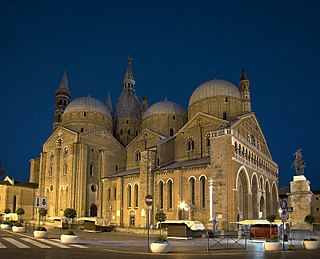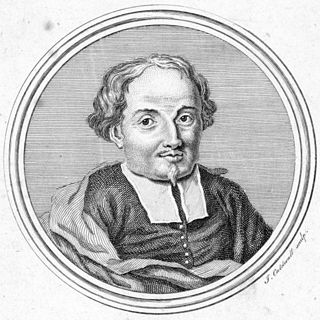Related Research Articles

Giuseppe Ottavio Pitoni was an Italian organist and composer. He became one of the leading musicians in Rome during the late Baroque era, the first half of the 18th century.

Domenico Allegri was an Italian composer and singer of the early Baroque Roman School. He was the second son of the Milanese coachman Costantino Allegri, who lived in Rome with his family, and was a younger brother of the more famous Gregorio Allegri. Costantino sent three sons, Gregorio, Domenico and Bartolomeo, to study music at San Luigi dei Francesi, under the maestro di capella Giovanni Bernardino Nanino, brother of Giovanni Maria Nanino. The little boy had as schoolmates his elder brother Gregorio and then Antonio Cifra, Domenico Massenzio and Paolo Agostini.

Trastevere is the 13th rione of Rome, Italy. It is identified by the initials R. XIII and it is located within Municipio I. Its name comes from Latin trans Tiberim.
Robin Mallapert was a French musician of the Renaissance, probably a composer, who spent most of his life in Rome. He is best known as the teacher of Palestrina.

The Basilica of Santa Maria in Trastevere ; English: Our Lady in Trastevere) is a titular minor basilica in the Trastevere district of Rome, and one of the oldest churches of Rome. The basic floor plan and wall structure of the church date back to the 340s, and much of the structure to 1140–43. The first sanctuary was built in 221 and 227 by Pope Callixtus I and later completed by Pope Julius I. The church has large areas of important mosaics from the late 13th century by Pietro Cavallini.

Santa Cecilia in Trastevere is a 5th-century church in Rome, Italy, in the Trastevere rione. It is deducated to the Roman martyr Saint Cecilia and serves as the conventual church for the adjacent abbey of Benedictine nuns.
Orazio Benevoli or Benevolo, was a Franco-Italian composer of large scaled polychoral sacred choral works of the middle Baroque era.

The Pontifical Basilica of Saint Anthony of Padua is a Catholic church and minor basilica in Padua, Veneto, Northern Italy, dedicated to St. Anthony of Padua.
Maurizio Cazzati was a northern Italian composer of the seventeenth century.
Antonio Maria Abbatini was an Italian composer, active mainly in Rome.

Cataldo Vito Amodei was an Italian composer of the mid-Baroque period who spent his career in Naples. His cantatas were important predecessors to the active cantata production of 18th-century Naples, and he stands with the elder Francesco Provenzale and younger Alessandro Scarlatti as among the principal Italian cantata composers. Other surviving works include a book of motets dedicated to Leopold I, Holy Roman Emperor; a serenata; two pastorales; two psalms; and four oratorios, which were important contributions to their genre.

Francesco Foggia was an Italian Baroque composer.
Gaetano Capocci was a composer, organist and maestro.
Angelo Berardi was an Italian music theorist and composer.
Alessandro Melani was an Italian composer and the brother of composer Jacopo Melani, and castrato singer Atto Melani. Along with Bernardo Pasquini and Alessandro Scarlatti, he was one of the leading composers active in Rome during the 17th century. He is also ranked among the second school of Roman opera composers which began with his brother's 1668 opera Il Girello. He is chiefly remembered today for his large output of liturgical music that he wrote while serving in various musical posts in Rome. Of particular interest is the large number of polychoral motets that he produced and his eight ascribed oratorios. Three published collections of his liturgical music survive today along with numerous solitary motets from other published volumes. A number of original manuscripts also survive.
Father Francesco Antonio Calegari was an Italian baroque music theorist, composer and priest. Calegari was maestro di cappella at Basilica of Santa Maria dei Frari, Venice in 1705, and at the Basilica del Santo, Padua in the 1720s. Several manuscript copies of his treatise on consonance and dissonance survive.

Pietro Paolo Bencini was an Italian Baroque composer and Kapellmeister. He was the father of Antonio Bencini, who was also known as a composer of sacred works.

Jacopo (Giacomo) Puccini was an 18th-century Italian composer who lived and worked primarily in Lucca, Tuscany. He was the first of five generations of composers, the most famous of whom was his great-great-grandson, the opera composer Giacomo Puccini.
Giuseppe Ceccherini was an Italian composer and singing teacher. He was born in Florence, the son of Ferdinando Ceccherini (1792–1858), a noted tenor, composer, and the maestro di cappella of Florence's principal cathedral, Santa Maria del Fiore.
Giuseppe Paoloucci was an Italian composer, conductor and organist of Baroque music.
References
- ↑ http://www.consortiumcarissimi.it/index_files/Page962.htm%5B%5D
- ↑ Beekman C. Cannon: Music in the Archives of the Basilica of Santa Maria in Trastevere, Acta Musicologica, Vol. 41, Fasc. 3/4 (Jul.-Dec., 1969), pp. 199-212
- ↑ Graham Dixon: The Cappella of S. Maria in Trastevere (1605-45): An Archival Study, Music & Letters, Vol. 62, No. 1 (Jan., 1981), pp. 30-40
- ↑ Scanned image from the Düben database